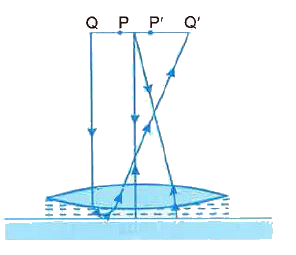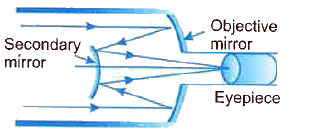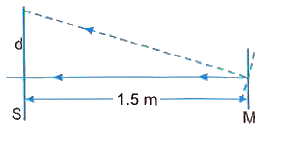N.C.E.R.T. TEXTBOOK EXERCISES from U-LIKE PHYSICS Chapter 22 RAY OPTICS AND OPTICAL INSTRUMENTS for Class 12
| Class 12 | PHYSICS |
| Chapter | RAY OPTICS AND OPTICAL INSTRUMENTS |
| U-LIKE PHYSICS | N.C.E.R.T. TEXTBOOK EXERCISES |
| Medium | English |
| Academic Year | 2023-2024 |
Question 1
A small candle, 2.5 cm in size is placed at 27 cm in front of a concave mirror of radius of curvature 36 cm. At what distance from the mirror should a screen be placed in order to obtain a sharp image? Describe the nature and size of the image. If the candle is moved closer to the mirror, how would the screen have to be moved?View SolutionQuestion 3
A tank is filled with water to a height of 12.5 cm. The apparent depth of a needle lying at the bottom of the tank is measured by a microscope to be 9.4 cm. What is the refractive index of water? If water is replaced by a liquid of refractive index 1.63 up to the same height, by what distance would the microscope have to be moved to focus on the needle again?View SolutionQuestion 4
Fig. 9.02(a) and (b), show refraction of a ray in air incident at 60∘ with the normal to a glass - air and water - air interface, respectively. Predict the angle of refraction in glass when the angle of incidence in water is 45∘ with the normal to a water - glass interface [Fig. 9.02(c)].
 View Solution
View SolutionQuestion 6
A prism is made of glass of unknown refractive index. A parallel beam of light is incident on a face of the prism. The angle of minimum deviation is measured to be 40∘. What is the refractive index of the materal of the prism? The refracting angle of the prism is 60∘. If the prism is placed in water (refractive index 1.33), predict the new angle of minimum deviation of parallel beam of light.View SolutionQuestion 11
A compound microscope conists of an objective lens of focal length 2.0 cm and an eyepiece of focal length 6.25 cm separated by a distance of 15 cm. How far from the objective should an object be placed in order to obtain the final image at (a) the least distance of distinct vision (25cm), and (b) at infinity? What is the magnifying power of the microscope in each case? View SolutionQuestion 12
A person with a normal near point (25 cm) using a compound microscope with objective of focal length 8.0 mm and an eyepiece of focal length 2.5 cm can bring an object placed at 9.0 mm from the objective in sharp focus. What is the separation between the two lenses? Calculate the magnifying power of the microscope.View SolutionQuestion 14
(a) A giant refracting telescope at an observatory has an objective lens of focal length 15 m. If an eyepiece of focal length 1.0 cm is used, what is the angular magnification of the telescope?
(b) If this telescope is used to view the moon, what is the diameter of the image of the moon formed by the objective lens? The diameter of the moon is 3.48×106m, and the radius of lunar orbit is 3.8×108m.View SolutionQuestion 15
Use the mirror equation to deduce that :
(a) an object placed between f and 2f of a concave mirror produces a real image beyond 2f.
(b) a convex mirror always produces a virtual image independent of the locatioin of the object.
(c ) the virtual image produced by a convex mirror is always diminished in size and is located between the focus and the pole.
(d) an object placed between the pole and focus of a concave mirror procuces a virtual and enlarged image.View SolutionQuestion 16
A small pin fixed on a table top is viewed from above from a distance of 50 cm. By what distance would the pin appear to be raised if it is viewed from the same point through a 15 cm thick glass slab held parallel to the table ? Refractive index of glass = 1.5. Does the answer depend on the location of the slab ?View SolutionQuestion 17
(a) Fig. 9.04 shows a cross-section of a Tight pipe' made of a glass fibre of refractive index 1.68. The outer covering of the pipe is made of a material of refractive index 1.44. What is the range of the angles of the incident rays with the axis of the pipe for which total reflections inside the pipe take place, as shown in the figure.
(b) What is the answer if there is no outer covering of the pipe ?
 View Solution
View SolutionQuestion 18
Answer the following questions :
(a) You have learnt that plane and convex mirrors produce virtual images of objects. Can they produce real images under some circumstances ? Explain.
(b) A virtual image, we always say, cannot be caught on a screen. Yet when we 'see' a virtual image, we are obviously bringing it on to the 'screen' (i.e., the retina) of our eye. Is there a contradiction ?
(c) A diver under water, looks obliquely at a fisherman standing on the bank of a lake. Would the fisherman look taller or shorter to the diver than what he actually is ?
(d) Does the apparent depth of a tank of water change if viewed obliquely ? If so, does the apparent depth increase or decrease ?
(e) The refractive index of diamond is much greater than that of ordinary glass. Is this fact of some use to a diamond cutter ?View SolutionQuestion 21
(a) Determine the 'effective focal length' of the combination of the two lenses in Exercise 9.10, if they are placed 8.0 cm apart with their principal axes coincident. Does the answer depend on which side of the combination a beam of parallel light is incident ? Is the notion of effective focal length of this system useful at all ? <> (b) An object 1.5 cm in size is placed on the side of the convex lens in the arrangement (a) above. The distance between the object and the convex lens is 40 cm. Determine the magnification produced by the two-lens system, and the size of the image. View SolutionQuestion 23
A card sheet divided into squares each of size 1mm2 is being viewed at a distance of 9 cm through a magnifying glass (a converging lens of focal length 9 cm) held close to the eye.
(a) What is the magnification produced by the lens ? How much is the area of each square in the virtual image ?
(b) What is the angular magnification (magnifying power) of the lens ?
(c) Is the magnification in (a) equal to the magnifying power in (b) ? Explain. View SolutionQuestion 24
(a) At what distance should the lens be held from the figure in Exercise 9.23 in order to view the squares distinctly with the maximum possible magnifying power ?
(b) What is the magnification in this case ?
(c) Is the magnification equal to the magnifying power in this case ? ExplainView SolutionQuestion 26
Answer the following questions :
(a) The angle subtended at the eye by an object is equal to the angle subtended at the eye by the virtual image produced by a magnifying glass. In what sense then does a magnifying glass provide angular magnification ?
(b) In viewing through a magnifying glass, one usually positions one's eyes very close to the lens. Does angular magnification change if the eye is moved back ?
(c) Magnifying power of a simple microscope is inversely proportional to the focal length of the lens. What then stops us from using a convex lens of smaller and smaller focal length and achieving greater and greater magnifying power ?
(d) Why must both the objective and the eyepiece of a compound microscope have short focal lengths ?
(e) When viewing through a compound microscope, our eyes should be positioned not on the eyepiece but a short distance away from it for best viewing. Why ? How much should be that short distance between the eye and eyepiece ?View SolutionQuestion 28
A small telescope has an objective lens of focal length 140 cm and an eyepiece of focal length 5.0 cm. What is the magnifying power of the telescope for viewing distant objects when
(a) the telescope is in normal adjustment (i.e., when the final image is at infinity) ?
(b) the final image is formed at the least distance of distinct vision (25 cm) ?View SolutionQuestion 29
(a) For the telescope described in Exercise 9.28(a), what is the separation between the objective lens and the eyepiece ?
(b) If this telescope is used to view a 100 m tall tower 3 km away, what is the height of the image of the tower formed by the objective lens ?
( c) What is the height of the final image of the tower if it is formed at 25 cm ?View SolutionQuestion 32
Fig. 9.12 shows an equiconvex lens (of refractive index 1.50) in contact with a liquid layer on top of a plane mirror. A small needle with its tip on the principal axis is moved along the axis until its inverted image is found at the position of the needle. The distance of the needle from the lens is measured to be 45.0 cm. The liquid is removed and the experiment is repeated. The new distance is measured to be 30.0 cm. What is the refractive index of the liquid ?
 View Solution
View Solution
All Exercises from U-LIKE PHYSICS Class 12 PHYSICS RAY OPTICS AND OPTICAL INSTRUMENTS
- ASSERTION-REASON TYPE QUESTIONS
- CASE BASED/SOURCE- BASED INTEGRATED QUESTIONS
- FILL IN THE BLANKS
- LONG ANSWER QUESTIONS-I
- LONG ANSWER QUESTIONS-II
- MULTIPLE CHOICE QUESTIONS
- N.C.E.R.T. TEXTBOOK EXERCISES
- SELF ASSESSMENT TEST (SECTION A)(FILL IN THE BLANKS)
- SELF ASSESSMENT TEST (SECTION A)(MULTIPLE CHOICE QUESTIONS)
- SELF ASSESSMENT TEST (SECTION B)
- SHORT ANSWER QUESTIONS
- TRUE OR FALSE
- VERY SHORT ANSWER QUESTIONS


